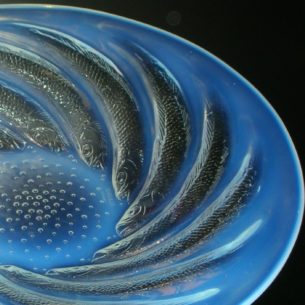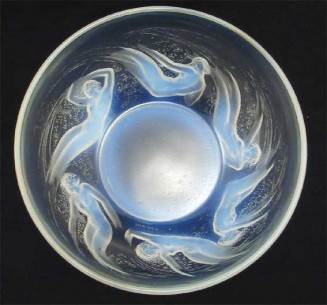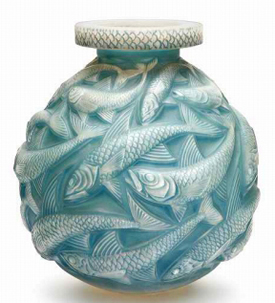 In every field, there are visionaries; true pioneers who open the minds of others to possibilities hitherto unthought of. Rene Lalique was, to the world of glass, one of these visionaries.
In every field, there are visionaries; true pioneers who open the minds of others to possibilities hitherto unthought of. Rene Lalique was, to the world of glass, one of these visionaries.
Born in 1860 in the small village of Ay, in the Marne region of France, Rene Lalique would rise to the top of multiple fields before passing away in 1945. He was born into a simple world, one without electricity, automobiles, or modern appliances, but he never shied away from change, embracing the potential of the industrial revolution every step of the way.
At the age of two, Rene was moved to the suburbs of Paris, where he eventually went to school at the Lycee Turgot, and then, after the death of his father (when he was just 16 years old), he became apprenticed to the jeweller Louis Aucoc. During this time, he also studied at the Ecole des Arts Decoratifs in Paris, and then finally, attended college in Sydenham, England, before returning to France in 1880. By 1881, Lalique was working as a freelance designer for many French jewelry firms, which came to include such big names as Cartier and Boucheron. In 1886, he acquired his own workshop in Paris. The dawn of the 1890s saw both the creation of some of Rene Lalique’s most celebrated jewelry designs, and the emergence of his fascination with glass, which he began to experiment with frequently.
Lalique was very much a man of his era in that his primary jewelry design motif was the natural world; the marriage of French and Japanese motifs in his creations fit in flawlessly with the Aesthetic and Art Nouveau movements as they swooped in to replace the heavy, plodding Victorian decor that preceded them. Rene’s use of glass, horn, pearls, semi-precious stones, enamel, and ivory was unusual in high-end jewelry at that time; he was not afraid to push boundaries and shatter conventions for the sake of his art. Indeed, he only used more typical, valuable gemstones when they suited the artistic vision of the piece—never simply to add value.
 Eventually, Rene’s love of glass outgrew the medium of jewelry, and he began to experiment with ashtrays, cachets, clocks, paperweights, car mascots, vases, decanters, pitchers, glasses and stemware, plates and bowls, knife rests, lamps and all manner of light fixtures, statues and plaques, panels, perfume bottles, and many other items — over 1500 objects, in total. During this era he created pieces so unique and stunning they are near-priceless collectibles today, such as his Cire Perdue vases. In 1912, he held an “all glass” exposition showcasing his pieces, drawing ever-greater interest in the artistic potential of glass.
Eventually, Rene’s love of glass outgrew the medium of jewelry, and he began to experiment with ashtrays, cachets, clocks, paperweights, car mascots, vases, decanters, pitchers, glasses and stemware, plates and bowls, knife rests, lamps and all manner of light fixtures, statues and plaques, panels, perfume bottles, and many other items — over 1500 objects, in total. During this era he created pieces so unique and stunning they are near-priceless collectibles today, such as his Cire Perdue vases. In 1912, he held an “all glass” exposition showcasing his pieces, drawing ever-greater interest in the artistic potential of glass.
The 1910s saw not only a diversification of Rene Lalique’s glass objects (ranging from one of a kind molded and cire perdue pieces, to more conventional objects like ashtrays, cachets, and tableware in hundreds upon hundreds of different designs), but also a variety of scale on which items were produced. While Rene still created many “one of a kind” art pieces, he also mass-produced quite a few of these objects, which saw a revolutionary amount of truly inspiring glass put into the hands of the people; for the first time, glass items of intricate beauty were not merely the province of the wealthy. Rene employed up to several hundred workers at one time, who aided him in not only the production of the glass itself, but also in adding many post-manufacture touches, such as enamelling, patinating, frosting, and polishing.
Rene’s introduction of art glass to the common person was no accident; it was one of his primary missions. An artist without pretensions is a beautiful thing, and Rene exhibited the sterling nature of his character and desire to make art attainable when, during an interview he did in the mid 1920’s (upon the opening of a new factory), he said he wanted to reduce the price of glass while still creating many different designs, so that every home could have a piece of art within its walls.
 Alas, this enlightened era of beauty and plenty could not last forever. World War 2 ravaged Paris, and in doing so, put Rene’s factories and molds in serious jeopardy, halting the production of Rene Lalique glass. The 1939 edition of Time magazine poignantly captures a tragic and no doubt terrifying moment in the life of the ageing artist, as he rushed to the town of Wingen where one of his factories was situated:
Alas, this enlightened era of beauty and plenty could not last forever. World War 2 ravaged Paris, and in doing so, put Rene’s factories and molds in serious jeopardy, halting the production of Rene Lalique glass. The 1939 edition of Time magazine poignantly captures a tragic and no doubt terrifying moment in the life of the ageing artist, as he rushed to the town of Wingen where one of his factories was situated:
“Wingen, in Alsace, is a one-factory town near the Maginot Line. Last month Wingen was evacuated. From Paris hurried short, scholarly, white-mustached René Lalique, now 79 and ailing, to salvage his irreplaceable molds. He found his factory’s fires out, soldiers at its gate. “No one goes in here,” they told him. Sick at heart, Glassmaker Lalique went back to Paris. Closed, possibly forever, was a glassworks which combined art with the assembly line.”
Mercifully, Rene was allowed to die in peace. Just days prior to his death on May 5th, 1945, he received the news that his Wingen factory in Alsace had been liberated, saved by Allied troops, and his valued molds were intact. Knowing that his legacy was safe, Rene passed away serenely at his home, with its famous glass panel doors, at 40 Cours la Reine in Paris.
He lies buried in a grave at the famous Le Pere Lachaise Cemetery in Paris, resting under a headstone inset with a glass crucifix of his own design. Today, the love of his amazing legacy is seen in the prices people are willing to pay to own a part of it; his vases have been known to sell for record-breaking amounts; nearly £600,000 pounds in one instance—but truly, the mark he has left on the world of art and glass is as priceless as it is indelible, and the spirit of the man ought be cherished and replicated as much as that which he created.
Guest article by JL Field

Very nice bio of a talented pioneer in Art. I found my first 5 pieces of beautiful crystal that just started by one auction in Lincoln Nebraska USA. Wish I knew 40 years ago.
I have a few pieces by Rene Lalique. All for sale. Including a rare cire perdue.